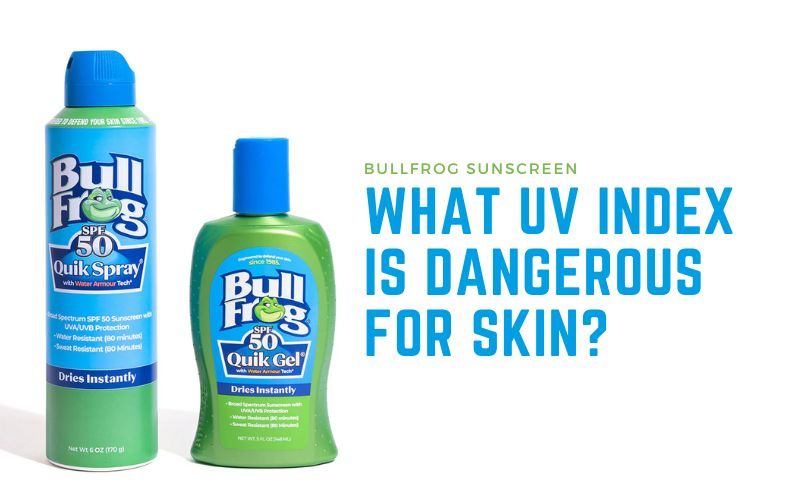
Are you planning a day at the beach or a hike in the mountains? While you may have the perfect outfit and all the right gear, it's crucial to remember an essential thing: sunscreen. But how do you know what UV index is dangerous for your skin, and what kind of sunscreen should you use to stay protected? Let's dive into it!
What is UV Index?
The UV Index is a measurement of the amount of ultraviolet (UV) radiation from the sun that reaches the Earth's surface. The UV Index is usually measured on a scale of 0 to 11+, with 0 indicating minimal UV exposure and 11+ indicating extreme levels of UV radiation.
What UV Index is Dangerous?
So, what UV index is dangerous for your skin? Any UV Index over 2 can cause skin damage, especially if you are exposed for a long time. However, UV Index levels between 3 and 7 are considered moderate to high risk and can cause sunburn, skin aging, and skin cancer. UV Index levels above 8 are considered very high risk and can cause severe skin damage, leading to skin cancer and other skin conditions.
To stay protected, wearing sunscreen with a high SPF and broad-spectrum protection is critical. Broad-spectrum sunscreen protects against both UVA and UVB rays. UVA rays can lead to premature aging and skin cancer, while UVB rays can cause sunburn and skin cancer. Bullfrog's Quik Spray & Quik Gel Broad Spectrum Sunscreen provides this protection, making it an excellent choice for outdoor activities.
Bullfrog's Quik Spray & Quik Gel Broad Spectrum Sunscreen
Bullfrog's Quik Spray & Quik Gel Broad Spectrum Sunscreen is perfect for those who love the outdoors. This sunscreen is water-resistant, making it perfect for swimming, surfing, or other water sports. It's also easy to apply, making it an excellent choice for those who are always on the go.

The Quik Spray formula provides a continuous spray that spreads evenly and dries quickly, making it ideal for those who don't have much time to spare. The Quik Gel formula is perfect for those who prefer a thicker consistency and want to ensure that every part of their skin is protected.

One of the best features of Bullfrog's Quik Spray & Quik Gel Broad Spectrum Sunscreen is that it includes a broad-spectrum SPF 50+ to provide maximum protection against harmful UVA and UVB rays. This high SPF rating ensures that you stay protected from the sun's harmful rays, no matter what UV Index you're facing.
Why Choose Bullfrog's Quik Spray & Quik Gel Broad Spectrum Sunscreen?
Bullfrog's Quik Spray & Quik Gel Broad Spectrum Sunscreen is an excellent choice for those who love the outdoors and want to stay protected from the sun's harmful rays. Here are some of the reasons why you should choose Bullfrog's Quik Spray & Quik Gel Broad Spectrum Sunscreen:
1. Broad-Spectrum Protection
Bullfrog's Quik Spray & Quik Gel Broad Spectrum Sunscreen provides broad-spectrum protection against UVA and UVB rays. This ensures that you are protected from the sun's harmful rays, no matter what UV Index you're facing.
2. High SPF Rating
Bullfrog's Quik Spray & Quik Gel Broad Spectrum Sunscreen has a high SPF rating of 50+, providing maximum protection against the sun's harmful rays. This makes it an excellent choice for those more susceptible to sunburn or skin damage.
3. Water-Resistant
Bullfrog's Quik Spray & Quik Gel Broad Spectrum Sunscreen is water-resistant for up to 80 minutes, making it perfect for water sports,
However, it's not just the amount of time spent in the sun that matters. The strength of the UV radiation is also important, and this is where the UV index comes into play.
The UV index is a measure of the strength of the UV radiation from the sun, and it ranges from 0 to 11+, with higher numbers indicating stronger UV radiation. The higher the UV index, the more dangerous it is to be exposed to the sun without protection.
So, what UV index is dangerous for the skin? Generally, a UV index of 3 or higher is considered to be dangerous for the skin. At this level, the sun's UV radiation is strong enough to cause damage to unprotected skin in as little as 15 to 30 minutes. This damage can lead to sunburn, premature aging, and an increased risk of skin cancer.
When the UV index reaches levels of 6 or higher, it's considered to be very high or extreme. At these levels, unprotected skin can be damaged in as little as 10 to 15 minutes. It's crucial to take extra precautions during these times, including seeking shade, wearing protective clothing, and applying a high-SPF, broad-spectrum sunscreen like Bullfrog's Quik Spray & Quik Gel Broad Spectrum Sunscreen.
Bullfrog's Quik Spray & Quik Gel Broad Spectrum Sunscreen is specially designed to provide maximum protection against harmful UV rays. Its broad-spectrum formula protects against both UVA and UVB radiation, while its water-resistant formula ensures long-lasting protection, even when swimming or sweating. Its unique Quik Gel formula also makes it easy to apply, so you can protect your skin quickly and easily without any mess or hassle.
When choosing a sunscreen, looking for one with a high SPF rating and broad-spectrum protection is essential. This will ensure that you're protected against both UVA and UVB radiation, which can cause damage to your skin. Bullfrog's Quik Spray & Quik Gel Broad Spectrum Sunscreen offers an SPF of 50+ and broad-spectrum protection, making it an excellent choice for anyone looking to protect their skin from the sun's harmful rays.
In conclusion, knowing what UV index is dangerous for the skin is essential for protecting yourself against the harmful effects of the sun. Always check the UV index before spending time outside, and take extra precautions when the UV index is high. Wear protective clothing, seek shade, and apply a high-SPF, broad-spectrum sunscreen like Bullfrog's Quik Spray & Quik Gel Broad Spectrum Sunscreen to keep your skin safe and healthy. With the proper protection, you can enjoy all the outdoor activities you love without risking your skin.